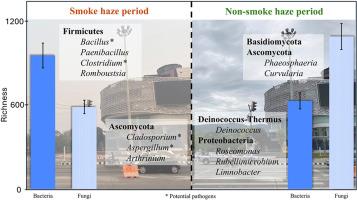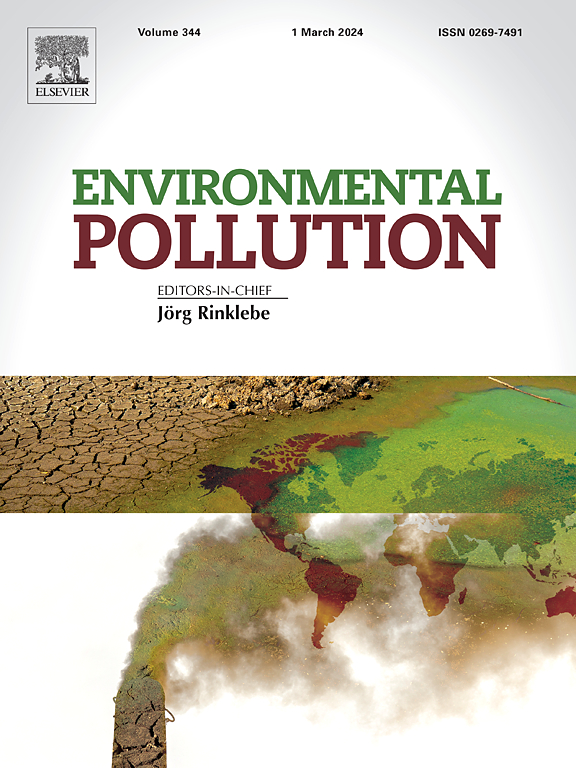Characterization of Airborne Microbial Communities in Northern Thailand: Impacts of Smoke Haze Versus Non-Haze Conditions
IF 7.6
2区 环境科学与生态学
Q1 ENVIRONMENTAL SCIENCES
引用次数: 0
Abstract
Data on airborne microorganisms, particularly in Southeast Asia, are more limited compared to chemical data. This study is the first to examine the community and diversity of microorganisms on PM2.5 in an urban area of Northern Thailand during both smoke haze and non-smoke haze periods of 2020. This study evaluated the composition of airborne bacteria and fungi and analyzed their association with the chemical composition of PM2.5 and meteorological variables. Significantly higher concentrations of PM2.5 and more chemical compounds were observed during the smoke haze period compared to the non-smoke haze period. Increased PM2.5 concentrations significantly altered both bacterial and fungal communities. The diversity and richness of airborne bacteria increased, whereas those of fungi decreased. The level of PM2.5 concentration (the carrier), the chemical composition of PM2.5 (the resources for survival), and the local meteorological conditions (relative humidity (RH)) were associated with the differences in bacterial and fungal populations. In addition, air originating from the west of the receptor site, influenced by both terrestrial and marine air mass routes, contributed to higher bacterial diversity and richness during the smoke haze period. In contrast, fungal diversity and richness were greater when the air came from the southwest, following a marine route. However, the primary health concern is pathogens, which were present in both periods (such as Clostridium, Aspergillus, and Cladosporium) and were especially abundant during smoke haze periods. This study highlights those airborne microorganisms, along with the particles and their chemical composition, are important components that can impact health, including that of humans, animals, and the environment.

泰国北部空气中微生物群落的特征:烟霾与非烟霾条件的影响
与化学数据相比,有关空气中微生物的数据,尤其是东南亚地区的数据更为有限。本研究首次对 2020 年烟霾和非烟霾期间泰国北部城市地区 PM2.5 上的微生物群落和多样性进行了研究。这项研究评估了空气中细菌和真菌的组成,并分析了它们与 PM2.5 化学成分和气象变量的关联。与非烟霾期相比,烟霾期的 PM2.5 浓度明显更高,化学成分也更多。PM2.5 浓度的增加极大地改变了细菌和真菌群落。空气中细菌的多样性和丰富度有所增加,而真菌的多样性和丰富度则有所下降。PM2.5 的浓度水平(载体)、PM2.5 的化学成分(生存资源)和当地的气象条件(相对湿度)与细菌和真菌群落的差异有关。此外,受陆地和海洋气团路线的影响,来自受体地点西部的空气在烟霾期间导致细菌的多样性和丰富度较高。与此相反,当空气来自西南部,沿海洋路径传播时,真菌的多样性和丰富度更高。然而,病原体才是人们最关心的健康问题,它们在两个时期都存在(如梭菌、曲霉和多孢霉),在烟霾期尤其丰富。这项研究强调,空气中的微生物、颗粒及其化学成分都是影响健康的重要成分,包括人类、动物和环境的健康。
本文章由计算机程序翻译,如有差异,请以英文原文为准。
求助全文
约1分钟内获得全文
求助全文
来源期刊

Environmental Pollution
环境科学-环境科学
CiteScore
16.00
自引率
6.70%
发文量
2082
审稿时长
2.9 months
期刊介绍:
Environmental Pollution is an international peer-reviewed journal that publishes high-quality research papers and review articles covering all aspects of environmental pollution and its impacts on ecosystems and human health.
Subject areas include, but are not limited to:
• Sources and occurrences of pollutants that are clearly defined and measured in environmental compartments, food and food-related items, and human bodies;
• Interlinks between contaminant exposure and biological, ecological, and human health effects, including those of climate change;
• Contaminants of emerging concerns (including but not limited to antibiotic resistant microorganisms or genes, microplastics/nanoplastics, electronic wastes, light, and noise) and/or their biological, ecological, or human health effects;
• Laboratory and field studies on the remediation/mitigation of environmental pollution via new techniques and with clear links to biological, ecological, or human health effects;
• Modeling of pollution processes, patterns, or trends that is of clear environmental and/or human health interest;
• New techniques that measure and examine environmental occurrences, transport, behavior, and effects of pollutants within the environment or the laboratory, provided that they can be clearly used to address problems within regional or global environmental compartments.
 求助内容:
求助内容: 应助结果提醒方式:
应助结果提醒方式:


